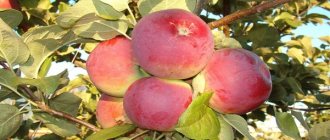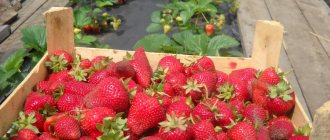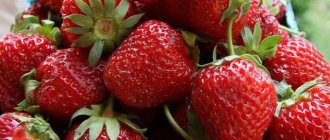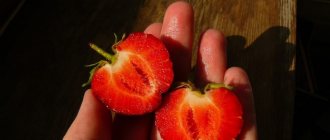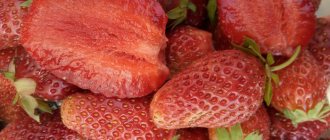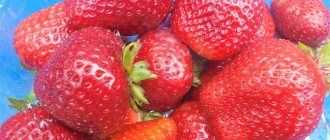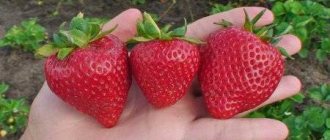Bereginya is a non-repairing variety of domestically produced garden strawberries. The variety was bred by scientists from the Kokinsky stronghold of the All-Russian Selection and Technological Institute of Horticulture and Nursery Growing. To obtain this variety, the following varieties were used:
- Gonzago.
- American Concorde.
Since 2007, domestic garden strawberries Bereginya began to undergo state tests. In 2012, the variety was accepted into the State Register of the Russian Federation.
This variety is recommended to be grown in the Central region of our country.
In today's publication you can find a description of the variety, photos of Beregini berries and reviews of gardeners who managed to grow a domestic beauty on their plot.
Characteristics of the Bereginya variety
Beregini's bush is medium-sized, semi-spreading, heavily covered with leaves. The leaf blades are medium in size, slightly wrinkled. The color of the leaves is light green. The leaves are glossy.
The flowers of Bereginya garden strawberries are bisexual, which indicates self-fertility. That is, additional pollinators are not needed for this variety.
The inflorescences are compact, consisting of a large number of medium-sized white flowers.
Peduncles are quite strong, located at the level of the leaves.
The bush produces a moderate amount of tendrils. Mustache of medium length, pale red color.
Beregini's fruits are medium-sized and blunt-conical in shape. The berry does not have a neck. The shell is orange-red, glossy. The pulp is red in color, dense in structure, very juicy. The berry exudes a pleasant strawberry aroma.
Despite the high density of the berries, they still have small voids inside.
The achenes are yellow in color and located superficially.
The berries have dessert taste. Beregini fruits are very sweet. At the same time, there is a slight note of sourness, which only complements the flavor palette. Tasting rating of Beregini berries - 4.5 points out of 5.
Composition of substances per 100 g of product:
- Sakharov - 5.7 g.
- Acids - 0.8 g.
- Vitamin C - 79 mg.
Due to their high density, berries are very easy to transport over long distances. Also, this contributes to the long-term preservation of the crop after harvesting.
This variety is universal. Beregini berries are suitable for fresh consumption and for processing into jams, preserves, compote. Also, the fruits of these garden strawberries can be frozen.
The variety is quite late in maturity. The ripening of berries begins approximately in the second decade of June. Fruiting is uniform throughout the entire growing season. The berries do not become smaller by the end of the season.
Beregini's berries are quite small, on average about 15 g. There are also specimens weighing 30 g.
Productivity is also not the highest. From 1 hectare you can harvest 150 centners of garden strawberries. On average, about 350 g of strawberries are harvested from 1 bush, which is very little compared to many Dutch varieties, which produce about a kilogram of berries from 1 plant.
Reproduction
Most often, Bereginya strawberries are propagated in one of two ways: by dividing the bush and by mustaches (vegetative shoots). Reproduction by whiskers is more common because:
- Bereginya forms a large number of mustaches;
- the mustache takes root better;
- the mustache forms the root system more easily and grows faster;
To form planting material, the most powerful shoots of the first order are used. Transplanted in the fall, they begin to bloom in the spring. In the first year, it is better to remove flower buds so that the bush actively grows and gains green mass.
The Bereginya variety is one of the most popular among the late varieties and many gardeners speak only positively about it. This means that it deserves to take a place in the collection of strawberry novelties in your garden.
Positive and negative qualities of this variety
Domestic garden strawberries have a lot of advantages, which is why they are actively cultivated on gardeners’ plots. Among the main advantages of Beregini it is worth highlighting:
- The variety is bisexual, which makes it self-pollinating. Bereginya does not need to plant an additional pollinator plant.
- The berries do not become smaller by the end of the season.
- The bushes form a sufficient number of tendrils, which allows strawberries to be propagated in this particular way.
- Bereginya is unpretentious to weather conditions and can grow in any region of our country.
- She has a fairly strong immune system that protects her from a number of diseases.
- The berries have high commercial quality. The berries are beautiful, sweet, and easily transported over long distances.
At the same time, we should not forget about the disadvantages of this variety. In general, there are not so many of them:
- Despite its strong immunity, the variety is quite susceptible to diseases such as gray rot. It is worth immediately noting that this disease develops in conditions of high humidity, so if you properly care for the crop, the risk of gray rot will be minimal.
- The berries may seem small, especially to those gardeners who have grown Dutch varieties of garden strawberries.
Advantages and disadvantages
It is impossible not to note the following advantages of Bereginya strawberries:
- High taste and commercial qualities - the harmonious taste goes well with the good density of the berries.
- The berries are of good size and also retain their size towards the end of fruiting.
- Good yield.
- There are no problems with reproduction - many whiskers are formed, the rosettes take root well.
- Good frost resistance and winter hardiness.
- High resistance to major pests and diseases of strawberries.
Among the disadvantages, one can note only the susceptibility to gray rot in berries in damp weather conditions.
Correct fit
Before starting planting work, it is necessary to select and prepare a site. Choose a sunny place, without neighboring trees or tall crops (sunflowers, corn, etc.). The area must be clean, free of weeds.
6 months before planting strawberry seedlings, the garden is fertilized. Humus is used at the rate of 8 kg per 1 m2.
It is also desirable that the site be protected from northern winds, but at the same time have good natural aeration.
The planting scheme itself looks like this:
- The first step is to dig out the planting hole. Its diameter is about 30 cm, and its depth depends on the length of the root system, but on average 15-30 cm.
- The holes are dug at a distance of 25-30 cm from each other. The distance between the holes is maintained at around 60-70 cm. This distance will allow you to easily care for the crop and harvest the crop without any problems.
- After the holes are dug, they are watered generously with water. About 1000 ml of water is consumed per hole.
- When the water in the holes is absorbed, seedlings are placed in them. The seedlings must be placed strictly vertically in the hole, while carefully straightening the root system.
- After the seedling is placed in the hole, it is sprinkled with soil and compacted. At the end of planting, the plants are watered again. The consumption is the same, about 1 liter of water per 1 bush.
Possible diseases and their treatment
Thanks to her “parents”, Bereginya quite steadfastly tolerates diseases and pests common to strawberries, but her weak point is gray rot.
In order to avoid the plantation being affected by this disease, you must follow a few simple rules:
- Inspect bushes and berries daily for signs of disease.
- Follow the landing rules. The planting pattern (50 cm by 30 cm) will prevent the spread of the disease through the bushes.
- Weeding and mulching the soil between the bushes.
- If there is a disease on one of the bushes, it must be carefully removed and destroyed away from the plantation.
If you follow the recommendations of professionals, the incidence of Bereginya strawberries by various types of diseases is extremely small.
Rules of care
Despite the fact that garden strawberries seem to be a complex crop, caring for them is quite simple. The basis of care is timely watering and fertilizing of the plant. Also, if the variety has a tendency to develop strong whiskers, the whiskers will need to be removed.
We also recommend reading: Description of the Eliane strawberry variety
Feeding
Fertilize strawberries 3 times per season:
- In the first year after planting seedlings, the crop does not need fertilizers. Starting from the second year of life, the plant begins to be actively fed. The first feeding is carried out immediately after the end of the cold weather, in early spring. At this time, it is advisable to feed garden strawberries with nitroammophos (the solution is prepared as follows: dilute 1 tablespoon of the substance in a bucket of water).
- During the formation of ovaries, the plant needs phosphorus-potassium fertilizers.
- In the fall, after harvesting, strawberries are fed with organic matter. The plant needs it in order to saturate it with nutrients and prepare it for winter sleep.
Watering
Lack of moisture can lead to a deterioration of the plant's immune system or its complete death. Therefore, you should always water your garden strawberries. But at the same time, we should not forget that the variety is highly susceptible to gray rot, which, by the way, develops in conditions of high humidity, so water the strawberries moderately, without creating a wetland around.
Usually water Bereginya once a week. Such watering is quite enough to ensure maximum crop productivity.
During dry periods, the number of waterings is increased to 2 per week, sometimes up to 3.
If a drip irrigation system is not used, then it is advisable to water the strawberries in the morning and evening, when the sun is in an inactive phase and cannot burn the leaves.
Water the garden strawberries with settled warm water. You cannot water from a well, as cold water can lead to the development of various diseases.
Productivity
The bushes begin to produce a stable harvest in the second year after transplantation. The average yield per plant is 350-600 g; in tests of the variety, the yield per hectare was never less than 150 tons, but it can be increased almost twice.
The first berries appear at the end of June, the bushes bear fruit for several weeks. Bereginya is perfectly stored after collection and does not deteriorate during transportation or exposure to the sun. Thanks to its taste, the variety has won the trust of tasters and is recommended for fresh consumption.
Pests and diseases
The variety feels great in various climatic growing conditions. It has fairly high frost resistance and is resistant to heat.
According to many experts, Bereginya has higher immunity levels than most varieties of garden strawberries (tests were carried out in 2006-2008). The variety is resistant to diseases such as verticillium. Also, it is rarely affected by various fungal diseases. As for parasites, Bereginya is very rarely infested by a common insect - the spider mite.
In this case, you need to take into account the fact that garden strawberries show good immunity only in good growing conditions, so you need to provide them with proper care.
Growing
Maintenance is not difficult, the main thing is to water it on time - the soil should not dry out. Weeds are removed as they appear. It is advisable to immediately pull them out by the roots - this will make subsequent cleaning easier - the fewer roots of weeds in the ground, the fewer weeds themselves. Weeding is needed constantly. It is done after watering, when the water is absorbed, so that the soil does not crust over. For the winter, you can mulch the ground 15-20 cm with straw; agrofibre is also suitable.
Interesting!
Interesting! Treatment for diseases of Bereginya strawberries is rarely required, but for pests a couple of times a season will not hurt. If such problems are not uncommon on the site, it is worth carrying out preventive spraying with folk substances 3-4 times during the growing season.
Feeding and care photo
- The first is needed for the growth of the root system and foliage. In this case, nitrogen substances are needed.
- During flowering, potassium, calcium, manganese, phosphorus, iron, boron and many other substances - complex fertilizers - will not interfere with the bushes. But the amount of nitrogen needed is minimal. Such fertilizers help increase productivity and improve the immune system.
- At the end of the season, when the bushes have faded and the entire strawberry crop has been harvested, it is possible, and even necessary, to feed the plants with calcium and phosphorus to restore the strength of the strawberries.
It is recommended to grow Bereginya according to the standard scheme: 50 cm between rows, 30 cm between bushes. The only weak point of the variety is gray rot, so the best conditions for it would be sandy loam soil and an open sunny area. The variety is not afraid of the sun; its berries are resistant to sunlight.
In order to plant Bereginya strawberries, you first need to prepare the soil:
- Planting should be done in the spring, fertilizers should be added to the soil, and the land should be cleared of weeds.
- After this, planting material is prepared, which can either be purchased or prepared by its owner from the mustache that grows abundantly in this variety. They take root remarkably well, not inferior in yield to the mother bush.
- A very important point when planting strawberries is to properly cover the bushes with soil. The roots must be completely immersed in the ground, and the growing point from which the leaves grow must remain at the top. If this point is buried in the ground, the bush will not grow and will simply die.
- The best prevention against diseases and weeds after planting is to use artificial materials to cover the ground or mulch with straw. This will save time on weeding and will prevent the spread of disease between the bushes.
After growing strawberries in a certain place for 5 years, they must be transplanted to a fresh place, otherwise a strong drop in yield will follow. This area should not be planted with strawberries for 5 years and only then can planting be repeated. Many have 5 beds and constantly change them in turns.
Reviews from gardeners
Valentina Yurievna, Kyiv, 52 years old.
I liked the Bereginya variety. Garden strawberries of this variety have a wide cone-shaped shape, slightly flattened. The pulp is tender, without fibers. The berries are large. The leaves have never been sick, although I have been growing Bereginya for the 5th year now. Among the shortcomings I would note poor resistance to moisture. When it rains, the berries rot, not all of them, of course, but some do.
Victor Dmitrievich, Ryazan, 42 years old.
I grew Bereginya in 2012, it showed itself as an ordinary variety of garden strawberry, approximately at the same level as Tsarina. The first berries weighed about 35 g, then they became very small, although I found in the description that they should not be small. The yield is high, despite the small size of the berries. Immunity is also good; in the two seasons that I cultivated it, I didn’t get any sores. But still, if compared with the Tsarina, then the Tsarina will be better, in my opinion.
History of creation
The Bereginya strawberry owes its birth to a group of breeders led by S.D. Aitzhanova, working at the Kokinsky stronghold of VSTISP, operating on the basis of the Bryansk Agricultural Academy. The parents of this variety were the famous Nightingale - also the fruit of the creation of S.D. Aitzhanova, known for its resistance to almost all the main misfortunes that plague strawberries (frost, winter thaws, diseases, pests), and Induka, a Dutch variety that can boast of its good yields. Strawberry Bereginya successfully combined the main parental qualities, which aroused great interest among both amateur gardeners and professionals.
Comment! Bereginya was included in the State Register of Breeding Achievements of Russia after lengthy tests quite late, in 2012.
It was zoned only in the Central Federal District, but this variety of strawberries is happily grown in the territory from the Krasnodar Territory to the Bryansk Region and even in the Urals and Siberia.
How to grow strawberries Bereginya
When planting and further growing plants, it is necessary to follow certain technology
In order for the bushes to actively develop and bear fruit abundantly, it is important to select healthy seedlings, properly prepare them for planting and decide in advance on the location on the site
How to choose good strawberry seedlings
Choosing strawberry seedlings in the summer is quite simple - healthy seedlings look fresh in appearance and have dense foliage. If the selection is made in the spring, when the seedlings have not yet grown leaves, the following nuances should be taken into account:
- It is better to choose healthy seedlings bred from mother plants. Such seedlings have increased resistance to diseases and pests. Healthy strawberries produce more yield than regular ones.
- You should buy seedlings from trusted producers. This will avoid purchasing low-quality seedlings.
- Plant roots should not be damaged. It is worth externally inspecting the root system and making sure it is in proper condition.
Choosing a location on the site
To grow a large crop, you need to choose a suitable place on the site. Plants prefer sunny areas with slightly acidic soil. The area must be protected from wind gusts, while a completely unventilated location can provoke the development of infections.
Landing rules
When planting seedlings with bare roots, it is necessary to place the seedlings in prepared holes so that the roots and core remain at soil level. Roots that are too elongated can be trimmed to 6-8 cm. Using seedlings with a closed root system, you need to remove the seedlings from the container without destroying the earthen ball.
How strawberry varieties have changed with climate change
It is noteworthy that our winters have changed and become milder. Previously, back in the days of my childhood, in the 1970s, knee-deep snow fell in the Moscow region already at the beginning of November, and this happened every winter, it was normal. People wore hats with ear flaps and winter coats to the November demonstrations. In those days, on the collective farm fields and on the 6-acre plot of land, their own assortment of strawberries was formed - varieties that were well adapted to wintering under a high snowdrift.
By the 1990s, everything had changed. Gradually, it became possible to wear sneakers all winter, something that was previously unimaginable. Now it’s good if the first stable snow cover of 10 centimeters is established by the New Year, otherwise the snow often falls and then disappears - and so on until January. Strawberry bushes are exposed several times during the winter in December and January.
And for this reason, our assortment has changed, new varieties have been developed that are more suitable for these conditions. At the same time, new varieties arrived from Europe, as our winters began to vaguely resemble European ones. Still, they are far from European, and frosts below -40°C occur regularly.
Some “Europeans” are even zoned here, but still their winter hardiness is lower than that of domestic ones. Therefore, I consider it the best combination when there are both domestic and foreign plants on the site, and I urge you not to abandon a variety if it is described as insufficiently winter-hardy. A combination will work: European varieties often have tastier berries, but in a particular winter, basic endurance can make all the difference.
So, when you plant side by side, say, two late varieties of strawberries - Alpha (one of the best domestic ones in terms of overall resistance to everything that can threaten strawberries) and Carmen (a Czech variety, also very worthy), then in the spring the difference is immediately visible in general appearance and the number of attacks: Alpha is safe and sound, the bushes are large, the foliage is completely preserved, it came out from under the snow large and green, and on Carmen there are several attacks, the foliage is partially withered and approximately 20% of the bushes are “half-dead.”
This state of the plantation in the spring is normal for the European varieties that have taken root in our country; they then quickly restore foliage, bloom well and generally bear fruit brightly, you just have to put up with some setbacks for the sake of high quality berries. And of course, you should help them winter if possible.
It is useful to know the pattern: young plants tolerate winter better than adults. In bushes after two harvests, some horns already stick out too much from the soil, they freeze more easily, so on mature plantations there may be more lunges. Hilling up such mature bushes with fresh soil helps with wintering.
Selecting a location
The amount of harvest depends on the right location. Strawberries grow well on sloping areas, preferring southwestern slopes. It does not have any soil requirements. But most of all it prefers chernozems and gray forest soils of light composition. The yield will be worse if you plant strawberries on loam and sandstone. It grows poorly on turf substrates. The place where this crop will grow should be predominantly dry, and groundwater should not be located close to the surface.
The type of strawberry in question loves sunlight very much, so the place should not be shaded. Strawberries can grow in one place for no more than five years, and then they need to be transplanted to another place. When planting the Bereginya variety, you need to follow the rules of crop rotation.
Good soils are those in which legumes, radishes and greens grew. After potatoes, tomatoes, peppers, the soil is unsuitable for planting strawberries: this can reduce the yield. You should not plant bushes of this plant next to trees with strongly developed roots.
Harvesting, transportability and storage of crops
The fruits are harvested as they ripen. The ripeness of the berries is indicated by the bright red color of the peel. Usually Bereginya strawberries ripen together, so the farmer collects a large amount of crop in one go. The berries are highly transportable. The harvest can be transported over long distances immediately after harvesting.
There are three ways to store strawberries:
- at room temperature (6–8 hours);
- in the vegetable section of the refrigerator (up to 5 days);
- in the freezer (9–12 months).
The strawberry variety Bereginya has many positive characteristics, which is why it has earned popularity among gardeners. With basic agricultural cultivation techniques, farmers manage to obtain a rich and unusually tasty harvest.
It’s hard to argue with the love for strawberries - it’s not for nothing that this berry is considered one of the most delicious and best-selling in the world. But caring for it is not the easiest - you can’t call it a berry for the lazy. But busy summer residents and gardeners burdened with a bunch of other worries dream of a variety that would at least be resistant to many troubles, and whose bushes would not need to be treated several times a season with various chemicals.
Perhaps one of the varieties that meets these requirements is the relatively recently developed strawberry variety Bereginya, reviews of which, along with a photo and its description, can help you decide whether it is suitable for your specific conditions or not.
This variety of strawberries has more than enough advantages, there are also disadvantages, so it is important to weigh the pros and cons and understand what exactly you want from strawberries first of all
Appearance of strawberries Bereginya
This medium-sized plant, which does not take up much space, will become a real decoration for your garden plot. The leaves look quite nice - they are large, shiny, light green in color, and there are not so many of them - on average 7-8 per bush.
The petioles of the middle lobe of the leaf are slightly longer than the lateral ones. The antennae that appear in the first warm days of spring are slightly reddish in color. It's always nice to watch the berries bloom. Strawberry Bereginya will delight you with bisexual flowers with white, small, not curled petals. The delicate spreading inflorescences look promising: it won’t be long before they are replaced by bright red, alluring berries.
Features of fruiting
A variety of traditional one-time fruiting (non-repairing), included in the category of late or medium-late in terms of ripening. In reviews of the Bereginya strawberry, gardeners indicate that the first berries begin to ripen mainly in the 3rd decade of June, 5-7 days earlier than Malvina, the latest variety of the crop existing today. The variety is characterized by intensive long-lasting flowering, extended fruiting and its stability over the years.
The bushes are small, semi-spreading, densely leafy. The leaves are light green in color, with a glossy sheen, medium wrinkled, slightly ribbed, concave, with blunt, wide teeth along the edges. Leaves, petioles and peduncles are pubescent. Compact multi-flowered inflorescences are formed on peduncles located at the level of the leaves. The flowers are medium-sized, white, bisexual, untwisted.
Characteristics of berries
The berries are large in size: the average weight for all harvests is 12.5-15 g (not critically smaller towards the end of fruiting and over the years), the maximum for the first fruits reaches 30-35 g, according to some reviews - up to 50 g. The shape is regular, blunt-conical, without neck. The color of ripe berries is orange-red with a glossy sheen.
The pulp is red, juicy, dense, sweet and sour, with a pronounced aroma. The taste is described as balanced and harmonious, sugary, with a light, unobtrusive sourness. Professional tasting assessments of fresh fruits – 4.5 points (out of 5). Given the excellent taste and high percentage of vitamin C, the berries are recommended for fresh consumption and are classified as table (dessert) for their intended purpose, also suitable for processing and freezing. According to the originator, they contain:
| Useful and nutritious substances | Quantity |
| Sahara | 5,7% |
| Acids | 0,8% |
| Vitamin C | 79 mg% |
The berries have good transportability and shelf life. During the testing period of the variety, yields averaged more than 150 c/ha (131-201), and the maximum possible is considered to be up to 300 c/ha.
How to grow Bereginya strawberries on a plot
The first thing to do is choose a location. It should be sunny, without any shading. Strawberries prefer sandy loam and light loamy soil. If the area has acidic soil, then a couple of years before planting strawberries, lime it and add sand before digging.
The soil for a strawberry bed is prepared in the fall if spring planting is planned, or vice versa. At the same time, rotted manure, superphosphate and potash fertilizers are introduced. In the middle zone, only spring planting of this crop is recommended.
Predecessor plants play an important role in growing strawberries, so a year before planting it is best to sow the bed with green manure, the choice of which is very large these days. After 4-5 years, the strawberries must be completely transplanted to another area, otherwise the yield will decrease.
Advice. It is best to create a new bed every year and uproot it after five years. So, over time, 5 beds of different ages will appear on the site, which will ensure a stable harvest. Strawberries can be returned to their original place only after 4 years.
To protect strawberry beds from various pests, it is practiced to sow marigolds and marigolds on them. This garden trick will reduce the threat of bushes being damaged by powdery mildew, fusarium and various rots. To repel slugs, you can plant parsley in strawberry beds.
